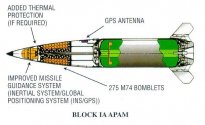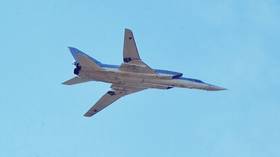For those questioning why the US never delivered ATACMS missiles to Ukraine, for example, they answer is quite simple. Rather than any desire not to give them any capability to strike Russian territory. the truth is the US has not manufactured any new ATACMS missiles since at least 2007.
M. Koffman recently made the same remark.
He still thinks the most important single system given to Ukraine is Starlink.
The actual reason for why Ukraine didn't get ATACMS is even simpler: it's a bad excuse for a tactical missile.
ATACMS was developed for the MLRS which as part of the AirLand Battle doctrine had a very specific role on the battlefield - strike at concentrated mechanized formations. It entered service in 1983.
ATACMS Block I (M39) despite its name was
not a tactical missile. It was the
long range delivery system as opposed to the
short range delivery system which was the M26.
- M26 (12 per M270 launcher) had range of 30km.
- M39 (2x per M270 launcher) had range of 165km.
Neither M39 nor M26 were GPS-guided and only used inertial guidance but it didn't matter because both had warheads
only with cluster munitions: M39 carried 950x larger APAM, M26 carried 644x smaller DPICM. There was no unitary warhead for either of them. M270 MLRS was the American version of BM-27 Uragan introduced in 1975 and pre-dated BM-30 Smerch which entered service in 1989.
This is ATACMS Block I:


After Cold War ended cluster munitions became problematic politically and expensive to maintain. To sustain the development of the MLRS system upgrades with unitary warheads were proposed because GPS provided sufficient precision but work only began after 2000 as part of GMLRS upgrade. A small number of upgraded ATACMS M48 with an unitary HE-frag warhead from Harpoon were produced, the rest were upgraded to M57 using M48 and earlier M39 bodies. M30 and M31 GMRLS were produced all new because they also had new solid fuel motors with greater range. M48 and M57 had reduced warhead mass - from 1000lbs/454kg to 500lbs/225kg to gain range from 165km to 300km.
But what is important is that M57 being developed from M39 which was a long-range delivery system for cluster munitions wasn't a high performance missile. It only flies at around 3,0 Ma and has a relatively depressed trajectory. Compare that to OTR-21 Tochka which has shorter range but a maximum speed of 5,0-5,5Ma and remember that Tochkas used by DPR/LPR forces were shot down by Ukrainian Buks and S-300 at a decent rate. Even some Iskanders which have an even higher peak speed and terminal stage maneuvering as well as decoys were shot down.
Giving ATACMS to Ukraine would not be problematic due to low stocks but would also be wasteful because Russian air defense would have even less problems with shooting them down because they have more modern SAM systems compared to Ukraine - Buk M2/M3, S-300V4, S-300PMU2, S-400 etc.
Of the handful of missiles that Pentagon could give to Ukraine most would be shot down and the only thing that would come of it would be bad PR.
Again we have the problem of American PR for weapons sales being mixed up with honest tactical assessment of the weapon's capability. American officials or journalists can't say "ATACMS is not good enough" because it will cause problems for Lockheed, especially now that HIMARS is getting traction thanks to GMLRS use in Ukraine - which also was accompanied by a marketing campaign presenting it as a Wunderwaffe. Michael Kofman also pointed out how inaccurate it was but he was providing tactical analysis while media were providing paid PR for Lockheed.
The whole "
DC doesn't want Ukraine to shoot into Russia" or even claims of low stocks of missiles (which is a real factor, as is their technical condition - GMLRS is being produced, ATACMS is only modernized old missiles) is really a way to avoid saying "
we don't have tactical missiles that won't be shot down by Russian air defenses".
GMLRS worked because it was shot in volleys of 6 or 12 which consisted of fast-moving (2,5Ma) small missiles. They were too small and too numerous to use Buks or S-300 against them effectively and Tor is not designed to deal with those types of threats. Both Tor and Pantsir are systems specialized against low-flying sub-sonic targets. So GMLRS really needed C-RAM which Russians didn't have so they had to adapt by rearranging their positions and providing better GPS-jamming - a passive defense rather than an active one. With ATACMS the target is large enough, range allows attacking targets behind frontlines at distances protected by higher tier of air defenses and there's a theoretical maximum of 4 to 6 missiles, but mostly 1 or 2 being fired. This means that a single battery of Buks or S-300 can shoot down an entire salvo of ATACMS.
You can easily imagine how many missiles Ukraine would have to get to be able to use it with any degree of effectiveness and how many HIMARS launchers - each with a single ATACMS - would have to be put to use for every attack. That is the real reason why ATACMS wasn't transferred.
Not sure where Gerasimov falls into. Plus he's pretty competent, see Gerasimov Doctrine. Implementation of this Doctrine meant that Russia has been planning this war for years including preparing its economy for it. Which it did, and enabled it to survive sanctions.
WHAT???
I had to take a double take when you posted this link because I know about Gerasimov's doctrine and the first thing about Gerasimov's doctrine is:
There Is No Thing Such As A Gerasimov's Doctrine.
And it's literally in the first two paragraphs of the link you posted:
The Gerasimov Doctrine, named after the Chief of the General Staff of the Russian Armed Forces army general Valery Gerasimov, is a pseudo-military doctrine created by the Western media and some Russian analysts.[1][2][3] It is based on Gerasimov’s views about American contemporary warfare,[4] putting interstate conflict and warfare on a par with political, economic, informational,[5] humanitarian and other non-military activities.[6][7][8][9] It became known after Mark Galeotti coined the term in his blog "In Moscow Shadows"[10] and the invasion and annexation of Crimea by Russia in 2014. Some Western analysts were convinced that the Russian actions reflected the "Gerasimov Doctrine"[1] helping to spread the term and making it a buzzword.
The idea of the existence of a "Gerasimov Doctrine" is contested by many researchers and specialists in Russian military thinking and doctrine. According to them, the key elements of the Gerasimov Doctrine underlie the concept of New Generation Warfare.[4][11] Many also argue that Gerasimov never wanted to present a doctrine and rather was asking the scientists of the Russian Academy of Military Science to do research to help him to understand the new ways of Western warfare.[12]
Ladies and gentlemen we have passed reddit and are now approaching tumblr at ludicrous speed. Please don't bother with your seatbelts because nobody is going to survive this.



